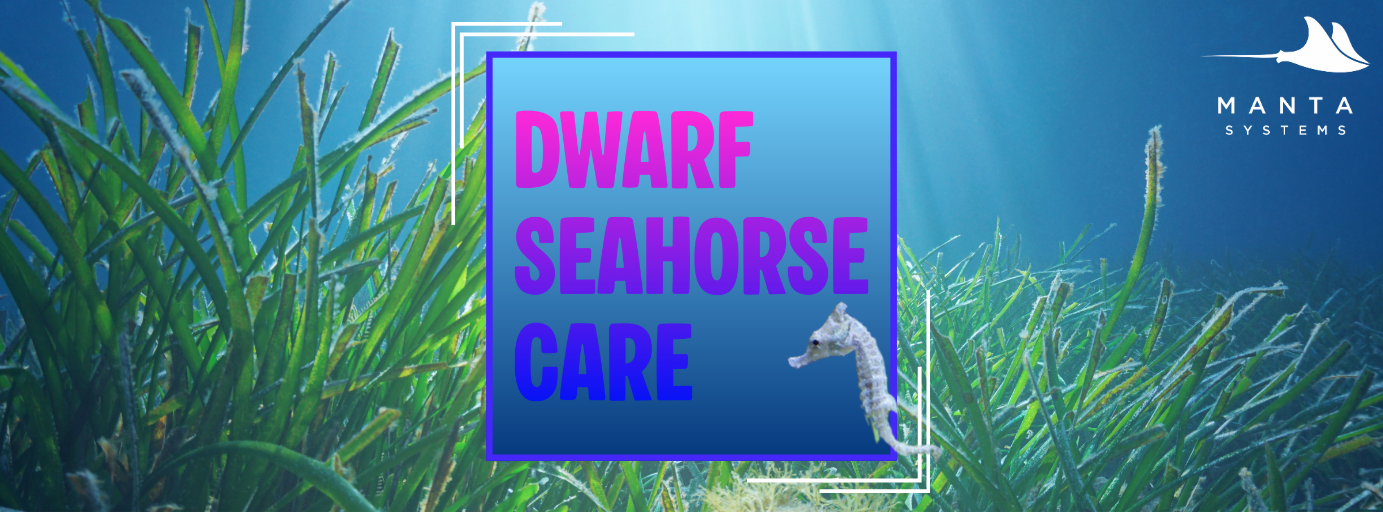
𝐃𝐰𝐚𝐫𝐟 𝐒𝐞𝐚𝐡𝐨𝐫𝐬𝐞 𝐂𝐚𝐫𝐞:
𝐓𝐡𝐞 𝐔𝐥𝐭𝐢𝐦𝐚𝐭𝐞 𝐆𝐮𝐢𝐝𝐞 𝐭𝐨 𝐇𝐢𝐩𝐩𝐨𝐜𝐚𝐦𝐩𝐮𝐬 𝐳𝐨𝐬𝐭𝐞𝐫𝐚𝐞
If you've ever dreamed of having a living, breathing work of art in your aquarium, look no further than the dwarf seahorse. These tiny marvels, no larger than your thumbnail, float through the water like mythical creatures. But here's the truth seasoned hobbyists know: dwarf seahorses aren't just miniature versions of their larger cousins. They're a specialized commitment that requires ditching almost everything you know about standard reef keeping.
I learned this lesson the hard way years ago. After successfully keeping larger seahorses, I assumed dwarves would be a simple step down. I was wrong. Their tiny size makes them incredibly vulnerable, and their specific needs are non-negotiable. This guide will walk you through exactly what it takes to succeed with these captivating animals, including the realistic daily time investment and the specialized setup required. This is a bisic overview of everything that is needed but please continue to read about their needs until you feel comfortable with their care and needs.
Dwarf Seahorses 101: Not Your Average Aquarium Pet
The dwarf seahorse (Hippocampus zosterae) is the smallest seahorse species in the world, native to the seagrass beds of the Gulf of Mexico and the Atlantic Coast. They typically reach just 1-2 inches in length and have a lifespan of 1-2 years in captivity when cared for properly.
What makes them so different?
-
Metabolism: They have extremely fast metabolisms and need to eat constantly—often every 10-20 minutes throughout the day.
-
Delicate Nature: They cannot compete for food with any other tankmates. This must be a species-only tank.
-
Specific Diet: They require live food multiple times a day. Frozen food is rarely accepted.
-
Low Flow Needs: They are poor swimmers and can be exhausted, injured, or killed by standard aquarium filters.
The Reality Check: Time Commitment
Before you fall in love, be honest about the daily routine:
-
Daily (15-20 minutes): Hatching brine shrimp, gut-loading them, feeding, and visually checking each seahorse.
-
Weekly (30-45 minutes): Two small water changes, tank cleaning, and equipment checks.
This is a hobby of consistency, not just initial setup.
Tamara’s Pro Tip: Success with dwarves is about embracing a "nano" mindset. Everything—from food size to water flow—must be scaled down to their miniature world. The reward is a captivating, slow-motion ballet few ever get to see.
Your Starter Shopping List: Get This First
Gather these items before your seahorses arrive:
-
Tank System: 5-10 gallon aquarium, glass or acrylic lid, small heater, sponge filter, air pump, and airline tubing.
-
Food Culture Station: Brine shrimp eggs, 2 x 1-liter bottles for hatcheries, phytoplankton supplement, optional copepod culture.
-
Tank Decor: Soft hitching posts (plastic gorgonians, etc.), fine sand or bare bottom.
-
Maintenance: Liquid test kit (Ammonia, Nitrite, Nitrate, pH), salt mix, source of RO/DI water.
Phase 1: Setting Up the Perfect Dwarf Seahorse Tank
Getting the environment right is 90% of the battle. Cut corners here, and you'll face an uphill struggle.
Tank Specifications
-
Tank Size: A 5-10 gallon aquarium is perfect. Larger tanks make it difficult for these slow movers to find enough food.
-
Filtration: Sponge filters only. Power filters, even on the lowest setting, will trap and kill dwarf seahorses. The sponge filter provides gentle biological filtration and surface agitation for oxygen exchange.
-
Heater: A reliable, small heater is essential to maintain a stable temperature between 72-78°F (22-26°C). Sudden fluctuations are a major stressor.
-
Lighting: Standard LED lighting is fine. Avoid intense lights that promote rapid algae growth.
Aquascaping for Safety and Comfort
-
Hitching Posts: This is crucial! Dwarf seahorses spend their lives anchoring themselves. Use:
-
Soft artificial plants (like plastic Gorgonians)
-
Caulerpa or other non-stinging macroalgae
-
Branching live rock with no sharp edges or pests like aptasia
-
-
Substrate: Fine sand or bare bottom is best. Coarse substrates can trap waste and detritus.
Tamara’s Pro Tip: Cycle the tank completely using the sponge filter before adding your seahorses. A mature, stable biological filter is your best defense against water quality issues.
Phase 2: The Culture Station – Your Key to Success
This is the most important part of your setup and where most attempts fail. Dwarf seahorses will rarely accept frozen or dead food. Their primary diet must be live, moving prey.
The Primary Food: Live Baby Brine Shrimp (BBS)
-
Why: Newly hatched brine shrimp (instar stage) are the perfect size and their movement triggers the seahorse's feeding response.
-
The Two-Bottle Hatchery System: This is the secret to reliability. There are other methods and products that you can purchase this is just one option.
-
Set up two separate 1-liter brine shrimp hatcheries.
-
Start them on alternating days. This way, you always have a fresh batch of shrimp ready to feed. If one hatch fails, you have a backup.
-
-
Gut-Loading: Before feeding, enrich the brine shrimp by letting them consume a phytoplankton supplement (e.g., Nannochloropsis) for 30-60 minutes. This passes vital nutrients to your seahorses. "Empty" brine shrimp have little nutritional value.
Supplemental Foods for Optimal Health
-
Copepods: Maintaining a thriving population of tiny copepods (like Tisbe) in the tank provides a constant, natural snack between feedings.
-
Rotifers: Another excellent small live food, especially for newly born fry.
Tamara’s Pro Tip: Your "seahorse station" isn't just the tank. It's the tank plus your two hatchery bottles and phytoplankton culture. Having this mini-ecosystem running smoothly is the true goal.
Phase 3: Ongoing Care and Maintenance
Water Quality: The Silent Killer
Dwarf seahorses are incredibly sensitive. Their small size and high feeding frequency mean waste builds up quickly.
-
Water Changes: Perform small, frequent water changes of 10-20% twice a week. This is non-negotiable for removing waste and replenishing trace elements.
-
Parameters: Keep them stable!
-
Ammonia/Nitrite: 0 ppm
-
Nitrate: < 10 ppm
-
Salinity: 1.020-1.025 (keep it stable!)
-
-
Acclimation: Drip acclimate new seahorses slowly over 60-90 minutes to avoid pH shock.
Tank Mates: The Short Answer is "No"
The long answer is also "no". Dwarf seahorses should be kept in a species-only tank. Even peaceful creatures can cause problems:
-
Snails and Hermit Crabs: Can injure seahorses or outcompete them for food.
-
Other Fish: Will either eat the seahorses, their food, or both.
-
Cleaner Shrimp: May bother or stress the seahorses.
The only exceptions are the beneficial copepods and microfauna that serve as a live food source.
Troubleshooting and Health
Common Behavioral Problems
-
Problem: Seahorses are not eating.
-
Causes: Brine shrimp are too old, water parameters are off, or current is too strong.
-
Solution: Test water quality, perform a change, and ensure you're feeding freshly hatched BBS.
-
-
Problem: Rapid tail curling or "snicking" without eating.
-
Causes: Sign of starvation or stress. They are trying to feed but are too weak or the food isn't stimulating enough.
-
Solution: Offer a different live food (like copepods) and review your hatching routine.
-
Disease Identification and Treatment
Dwarf seahorses are too delicate for harsh medications. Focus on gentle treatments and improving their environment.
-
Gas Bubble Disease (GBD):
-
Symptoms: Bubbles trapped under the skin, causing buoyancy issues.
-
Causes: Often related to bacterial infections or supersaturated gases from a faulty heater.
-
Treatment: Isolate the seahorse. A gentle freshwater dip (3-5 minutes in temperature- and pH-matched RO/DI water) can help. Check your heater.
-
-
Bacterial Infections (Tail Rot, Skin Ulcers):
-
Symptoms: White fuzzy patches, red lesions, or decaying tissue.
-
Causes: Almost always poor water quality.
-
Treatment: Isolate immediately in a hospital tank. Neomycin Sulfate or Methylene Blue baths can be effective.
-
Tamara’s Pro Tip: Keep a dedicated 2-gallon "hospital tank" ready with a small sponge filter and heater. I learned the importance of this when a single sick seahorse required me to treat the entire display, stressing all the animals. Isolation is the first and best step.
The Ultimate Reward: Breeding and Fry Care
If you have a healthy herd, breeding is likely. It's a fascinating process but comes with major challenges.
-
Identifying Pregnancy: A male's brood pouch will become enlarged and look "grape-like." The gestation period is about 10-14 days.
-
The Birth: The male will give birth to dozens of tiny, fully-formed seahorses, often at night or in the early morning.
-
The Fry Reality Check: Raising fry is an advanced project.
-
Food: The fry require even smaller food, like live rotifers, for their first week. You need a separate rotifer culture ready.
-
Survival: Fry are extremely delicate and mortality is high, even for experts.
-
Advice: For your first time, consider the fry a bonus. Focus on keeping the adults healthy. If you succeed with them, then consider attempting to raise a batch of fry.
-
Frequently Asked Questions (FAQ)
Q: Can I keep just one dwarf seahorse?
A: It's not recommended. Seahorses are social and do best in small groups (a "herd") of 4-6 individuals. They are more active and display more natural behaviors when kept together.
Q: Where can I buy dwarf seahorses?
A: You need to seek out specialized online retailers or breeders. Always ask if they are captive-bred; captive-bred seahorses are hardier and more acclimated to aquarium life than wild-caught ones.
Q: I'm going on vacation. What do I do?
A: This is the biggest challenge. Dwarf seahorses cannot go without food for more than a day. You must have a knowledgeable person who can come in daily to hatch brine shrimp and feed them. There are no reliable automated solutions but there are some DIY options online.
Q: Are they really that difficult?
A: They are not "difficult" in the same way as a sensitive coral. Their challenge is one of consistent, daily routine. If you can commit to the culture station and water changes, you can succeed. It's a test of dedication.
Conclusion: Is a Dwarf Seahorse Tank Right for You?
Keeping dwarf seahorses is less about traditional aquarium keeping and more about cultivating a miniature, specialized ecosystem. It's a hobby within a hobby, appealing to those who find joy in daily rituals and microscopic details.
The reward for this dedication is unparalleled. There is no greater satisfaction than watching a herd of these living jewels gracefully hitch to a gorgonian, their tails curled tight, as they hunt for the tiny brine shrimp you cultivated for them.
Before you take the plunge, ask yourself honestly: Can I commit to the daily hatching routine? Can I provide a safe, peaceful, and pristine environment?
If your answer is yes, then you are in for one of the most unique and enchanting experiences the aquatic hobby has to offer. Welcome to the world of nano wonders.
Happy Reefing!
References:
Foster, Smith, and Lance Ichinotsubo. The Conscientious Marine Aquarist: A Commonsense Handbook for Successful Saltwater Hobbyists. TFH Publications, 2015.
Giwojna, Pete. A Step-by-Step Book about Seahorses. TFH Publications, 2005.
Moe, Martin A. The Marine Aquarium Handbook: Beginner to Breeder. 3rd ed., Green Turtle Publications, 2013.




